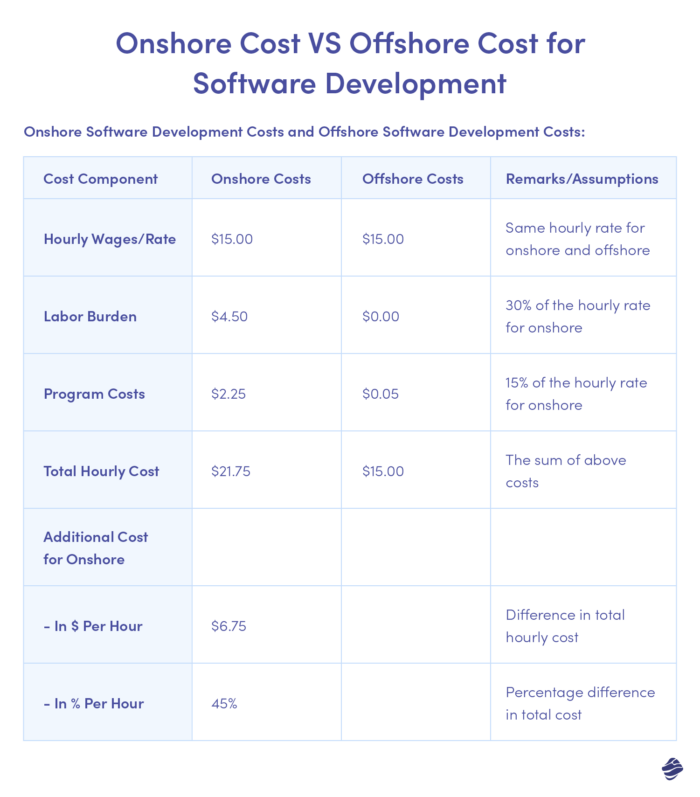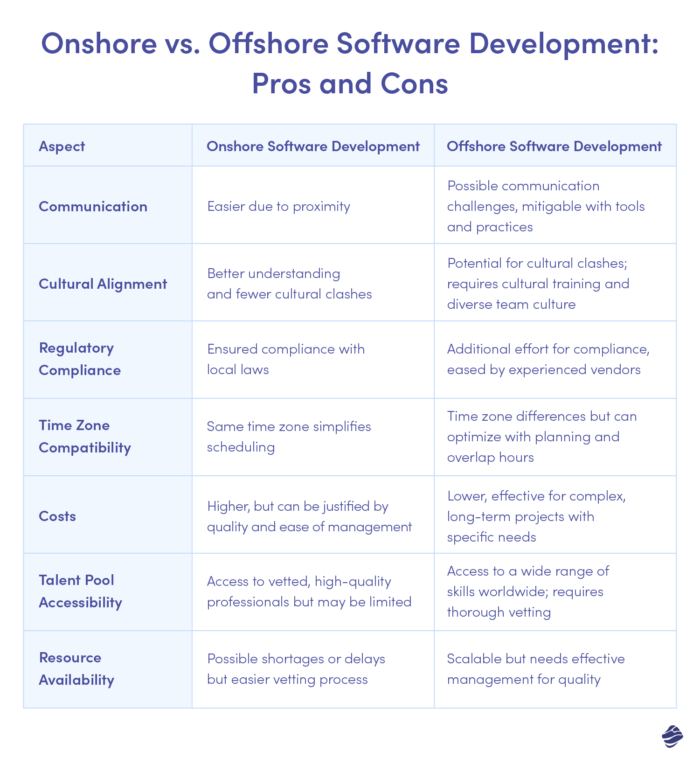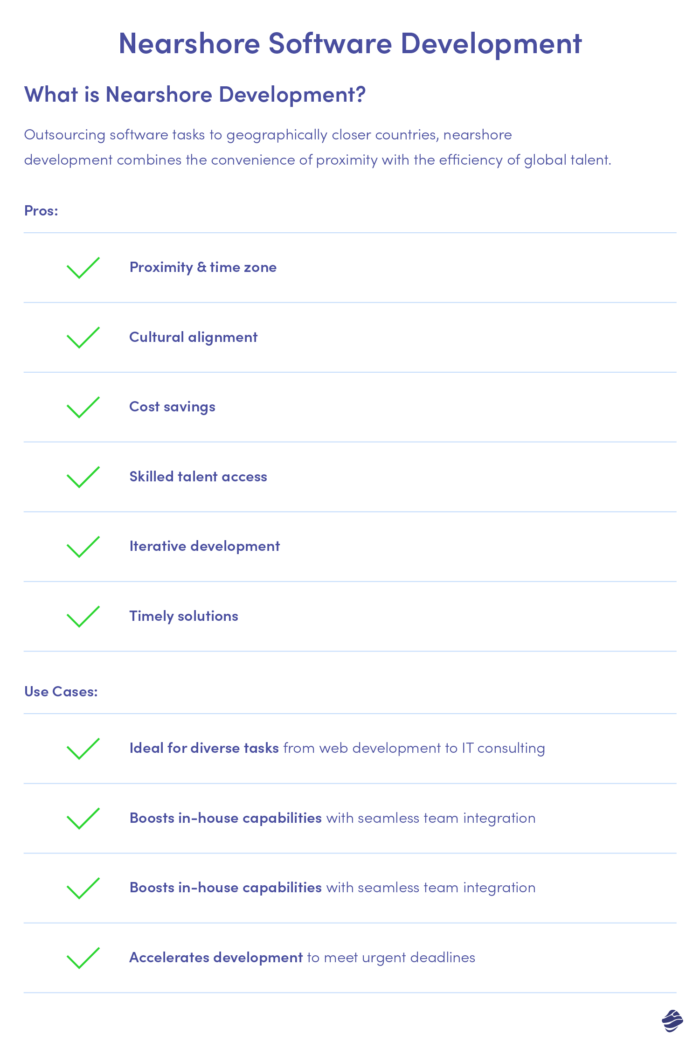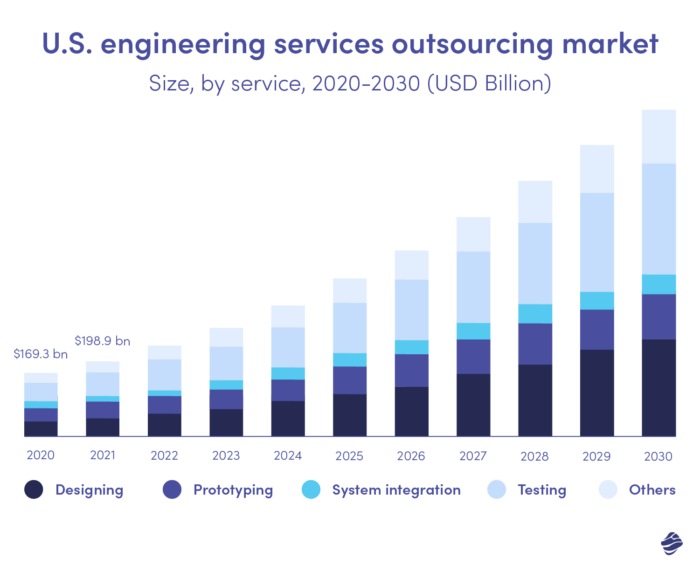In today’s rapidly changing technological landscape, selecting between offshore and onshore software development is a critical decision that can significantly impact the success of your project. This choice is crucial whether you are a CTO at an innovative startup, a Project Manager balancing tight deadlines, or an entrepreneur at the forefront of digital transformation.
Here’s a sneak peek at what you’ll uncover:
- Definition and Scope: Demystifying onshore and offshore development.
- Cost Implications: A thorough cost-benefit analysis of both models.
- Quality and Innovation: How each model influences output quality and innovation potential.
- Communication and Culture: Tackling the challenges and opportunities in cross-cultural teams.
- Time Zones: The double-edged sword of working across continents.
- Risk Management: Navigating the pitfalls of data security and confidentiality.
- Real-life Case Studies: Success stories and lessons learned.
- Choosing the Right Model: Tailored advice for your unique project needs.
- Hybrid Models: Exploring nearshoring and hybrid solutions.
- Future Trends: Preparing for the future landscape of software development.
Hiring Onshore vs Offshore Software Developers
In software development, onshore involves working with teams located in the same country, offering ease of communication and alignment with local business practices. Conversely, offshore development is about partnering with teams in different countries, often providing cost advantages but requiring more effort in managing time zones and cultural differences. Each model has unique strengths and challenges, influencing project outcomes in distinct ways.
Here’s a comparison table on the aspects of Onshore and Offshore Development:
| Aspect | Onshore Development | Offshore Development |
|---|---|---|
| Location | A team within the same country. | Setting up a team in a different country. |
| Proximity | Benefits from close proximity and enables easier and quicker access to the development team. | Geographical distance can pose challenges and may lead to communication and reporting delays. |
| Cultural Alignment | Shared cultural norms, languages, and business practices facilitate a smoother collaboration. | Cultural differences, varied work ethics, and inefficient time management practices can impact the outcome. |
| Communication | Boosts a deeper understanding with in-person communication opportunities. | Relies on digital communication tools and involves video conferences, emails, and chats for establishing communication. |
| Talent Pool | Limits the talent pool to the local workforce and restricts access to specialized skills. | Access to global and exceptional talent and expertise outside domestic borders. |
| Language Barrier | Communication in the local language and minimal language barriers. | May require clear communication strategies and proficiency support to navigate language challenges. |
| Time Zone Impact | Rarely impacted by time zone differences; hence easier to hold meetings and maintain collaboration. | Demands careful and effective meeting schedules to accommodate time zone variations. |
| Work Cycle | Aligns with local business hours; therefore, convenient for coordination. | 24-hour work cycle and offers potential time-saving benefits. |
What is Onshore Software Development?
Onshore development is like having your tech team next door. It’s about partnering with software developers and engineers who are based in the same country as your company. Think of it as a local collaboration where you share not just a time zone, but also cultural nuances and business regulations.
For a business located in the U.S., this would mean choosing a dedicated software development team in the U.S. This proximity can be a game-changer.
Key Features of Onshore Development:
- Easy Communication: When your team is just a phone call away, in the same time zone, aligning on projects becomes a breeze. No more late-night or early-morning calls!
- Cultural Alignment: Sharing a cultural background with your development team means fewer misunderstandings and a smoother workflow. It’s like working with people who speak your business language.
- Regulatory Compliance: Onshore teams are well-versed in local laws and regulations. This means less legal hassle for you, especially when handling sensitive data or compliance issues.
- Quick Turnaround: Proximity allows for faster iterations and more agile responses to changes. It’s like having a fast-forward button for your development cycle.
- Higher Initial Costs: Quality and convenience come at a price. Onshore development generally involves higher rates compared to offshore options.
Real-Life Examples of Onshore Software Development
Enhancing Healthcare App Development at Akido Labs
Akido Labs, a health-focused company involved in combatting public health crises, engaged Sonatafy Technology for custom software development to enhance their web and native mobile applications. Their goal was to rapidly onboard skilled engineers within the same timezone (PST) to meet increasing demand.
Sonatafy provided a tailored solution with full-stack engineers, demonstrating flexibility, adaptability, and a deep understanding of healthcare software requirements. This collaboration resulted in a successful enhancement of Akido’s applications, establishing long-term relationships with the engineers and integrating them seamlessly into the Akido team.
Benefits for Akido Labs from this onshore software development partnership included:
- Rapid Team Augmentation: Quick onboarding of skilled engineers.
- Timezone Alignment: Engineers in the same timezone facilitated smoother collaboration.
- Custom Software Development: Tailored solutions for web and native mobile applications.
- Healthcare Industry Expertise: Deep understanding of the healthcare sector’s specific needs.
- Seamless Team Integration: Sonatafy’s engineers blended well with the existing Akido team.
- Long-Term Professional Relationships: Development of ongoing collaborations with engineers.
- Effective Communication: Regular updates and transparency in project management.
- Flexibility and Adaptability: Adjustments made to fit Akido’s specific requirements and processes.
The Successful Journey of PepCare’s Onshore Software Development
PepCare, conceptualized by Bryon Kozak of Smile Doctors, partnered with Aloa to develop a comprehensive database software tailored for orthodontists, focusing on streamlining doctor-patient interactions and ensuring HIPAA compliance.
Their collaboration led to the creation of a user-friendly, orthodontic-specific dashboard, involving a product manager and a designer for translating ideas into functional design and development.
Key benefits of this onshore software development included:
- Close Collaboration: Enhanced communication and understanding between Bryon and the development team.
- Customized Development: Tailored software specifically for orthodontic practices, meeting specific industry needs.
- HIPAA Compliance: Ensured the software adhered to healthcare regulations, essential for patient data protection.
- Rapid Prototyping and Development: Quick turnaround from concept to MVP, then to a minimum sellable product (MSP).
- Market Readiness: Successful integration into North America’s largest orthodontist network, SmileDoctors, demonstrating its practical applicability and scalability.
These case studies underscore the significant advantages that companies can reap from this approach. By opting for onshore development, companies can efficiently meet their software needs, integrate seamlessly with external teams, and ensure the delivery of high-quality, compliant software solutions tailored to their specific requirements.
Pro Tip: Get the full potential of your business with Miquido’s custom application development services, tailored to elevate your brand and drive growth. Seamlessly adapt to industry changes, automate processes, and ensure top-notch security with custom software solutions designed to meet your unique business needs.
Take control of your digital transformation journey and partner with Miquido to turn your ideas into captivating digital products that stand out in the market. Let’s work together to bring your vision to life.
What is Offshore software development?
Now imagine your software development team is a skilled crew sailing in international waters. That’s offshore software development for you. It involves collaborating with software professionals located in a different country, often across oceans. This approach offers a voyage into global talent pools, often at a more budget-friendly cost compared to onshore options.
Offshore outsourcing can be a beacon for businesses looking to optimize expenses while accessing a wide range of technical expertise.
Key Features of Offshore Development:
- Cost Efficiency: Typically, offshore development is more affordable than onshore alternatives. It’s like finding a treasure trove of talent at a fraction of the cost.
- Access to Global Talent: Offshoring opens doors to a world of diverse, specialized skills and technological expertise. This means you can handpick experts for specific project needs.
- Scalability: Need to ramp up your team quickly? Offshore development makes scaling your project team up or down as smooth as sailing.
- Time Zone Differences: While challenging, time zone differences can be leveraged for round-the-clock development. It’s like having someone at the helm 24/7, ensuring continuous progress.
- Cultural and Communication Barriers: Navigating through cultural differences and communication barriers requires extra effort but can be managed with effective practices and tools.
Real-life examples of offshore software development
HelloFresh x Offshore Software Development Company Miquido

HelloFresh partnered with Miquido for offshore software development, aiming to digitalize the fresh food shopping experience and enhance dietary customization. By collaborating with Miquido, HelloFresh gained access to a wealth of tech expertise, accelerating its transformation into a digital culinary powerhouse.
Miquido’s offshore company solution focused on thoughtful design, flexible meal plans, and an educational component, resulting in 1 million daily active users and a valuation of €2.6 billion.
The partnership yielded significant benefits for HelloFresh, including:
- Elimination of in-house delays, ensuring a timely app launch.
- Reduced resource drain, saving costs by 40-60%.
- Seamless integration of cutting-edge tools such as Android, Golang, PHP, and React.
- Recognition as Google’s “Best Apps of 2016” recipient, solidifying HelloFresh’s position as the No. 1 meal-kit company globally.
Google x Offshore Software Development Company BairesDev
Google leveraged outsourcing software development services provided by BairesDev to ensure a consistent user experience across various platforms, including Android, iOS, TV, desktop, and mobile.
The offshore company, BairesDev, deployed a team of QA engineers who seamlessly integrated into Google’s development culture, conducting both manual and automated testing to identify and fix issues early in the development process. The offshore team’s expertise and rigorous hiring process ensured the right talent was placed on the job, contributing to streamlined development and maintaining a consistent user experience.
As a result, Google benefited in the following ways:
- Improved accuracy in software development services.
- Accelerated release times for software updates.
- Enhanced scalability of software across different platforms.
- Efficient identification and resolution of issues during development.
- Maintained leadership position in the market by delivering consistent user experiences across billions of lines of code and numerous applications.
The case studies presented underscore the substantial benefits that companies can reap from their partnership with an offshore development company. Through strategic outsourcing, these companies have harnessed the expertise of offshore teams to drive innovation, accelerate product launches, and navigate complex technological landscapes effectively.
How Much Does Each Model Cost?
When considering software development, cost is a critical and major consideration. Let’s dissect how each model, onshore software development VS offshore outsourcing, impacts your product budget. We will also go beyond just hourly rates and uncover hidden costs and potential savings.
Cost-Effectiveness Analysis: Digging Deeper into the Numbers
According to Deloitte’s 2020 Global Outsourcing Survey, a staggering 70% of businesses leverage outsourcing as a cost-saving tactic. For example, an onshore recruiter in the US might cost $21.75 per hour when including labor burden and program costs, compared to $15.00 for an offshore recruiter. This translates to a 45% cost differential, a significant factor for businesses aiming to optimize their budget.
- Individual Employee Costs
- Wages form about 70% of total labor cost, including base pay and performance bonuses.
- The labor burden, approximately 30% of the total cost, encompasses payroll taxes, benefits, and operational expenses.
- Example: In the UK, the labor burden might include specific healthcare contributions, differing significantly from countries like India.
- Program Costs
- These include management and attrition expenses, with offshoring often offering lower costs due to shared responsibilities and lower turnover rates.
- Onshore program costs could represent around 15% of the base pay per team member.
For a better overview of this study, check the table below:

Labor Burden Rate: 30% of the hourly wage for onshore development.
Program Costs: 15% of the hourly wage for onshore development.
Hourly Wages/Rate: The base rate is the same for both onshore and offshore development.*
*This table assumes that the base hourly rate for software development is the same for both onshore and offshore, but the additional costs (labor burden and program costs) are only applicable for onshore development, leading to a higher overall hourly cost for onshore development.
Practical Insights and Tools:
- Consultation with Specialized Service Providers: Instead of solely relying on online tools, consider directly engaging with an established offshore development company like Miquido. They can offer personalized consultations to discuss your specific budgets and needs.
- Case Studies and Testimonials: Look for case studies or client testimonials on the service provider’s website. These real-world examples can offer a clearer picture of what to expect in terms of results, cost savings, and the quality of services provided.
- Expert Webinars and Workshops: Participate in webinars or workshops conducted by offshore development companies. These events often provide valuable insights into the latest trends, best practices, and cost-effective strategies in software development outsourcing.
It’s crucial to make an informed decision between onshore and offshore software development. This choice should align not just with financial objectives, but also with operational needs, cultural considerations, and strategic goals.
By thoroughly understanding these dynamics and leveraging the right tools and insights, companies can make a decision that best supports their long-term success.
Pros and Cons of Onshore Software Development
When considering onshore software development for your project, it’s essential to weigh the advantages and disadvantages. Here’s a comprehensive list to help you make an informed decision:
PROS of Onshore Software Development:
- Easy Communication: Proximity allows for seamless communication and collaboration between your team and the development team, leading to faster feedback loops and better alignment.
- Cultural Alignment: Shared cultural background fosters better understanding and reduces the likelihood of miscommunication or cultural clashes.
- Regulatory Compliance: Onshore teams are well-versed in local laws and regulations, ensuring compliance and minimizing legal risks.
- Quality Assurance: Access to local talent pools often results in higher-quality deliverables and better adherence to industry standards and best practices.
- Time Zone Compatibility: The same time zone streamlines scheduling and facilitates real-time collaboration, reducing delays and improving productivity.
- Quality and Innovation Capabilities: Proximity to your development team can enhance quality control processes and foster a culture of innovation through close collaboration and knowledge sharing.
- Risk Management: Onshore development may mitigate some risks related to data security, intellectual property rights, and project confidentiality compared to offshore counterparts.
CONS of Onshore Software Development:
- Higher Costs: Onshore development typically comes with higher hourly rates compared to offshore options, leading to increased project costs.
- Limited Talent Pool: Depending on your location, you may have limited access to specialized skills or technologies, which could impact the scalability of your project.
- Resource Availability: Competition for local talent can lead to resource shortages or longer lead times for project kick-off.
- Market Dependency: Economic fluctuations or market trends in your local region may impact the availability and affordability of onshore development services.
- Risk of Burnout: Proximity may blur the boundaries between work and personal life, increasing the risk of burnout among team members.
Onshore software development offers numerous benefits, including easy communication, cultural alignment, and regulatory compliance. However, it comes with higher costs and limited access to talent.
Pros and Cons of Offshore Software Development
Offshore software development offers a range of benefits and challenges that must be carefully considered when planning your project. Here’s a comprehensive list to help you make an informed decision on software development outsourcing:
PROS of Offshore Software Development:
- Cost Savings: Offshore outsourcing typically offers lower hourly rates compared to onshore options, resulting in significant cost savings for your project.
- Access to Global Talent: Offshore teams provide access to a diverse talent pool from around the world, allowing you to tap into specialized skills and expertise not available locally.
- Scalability: Offshore development enables rapid scalability, allowing you to quickly ramp up or down resources based on project needs without the constraints of local talent availability.
- 24/7 Productivity: Working across different time zones allows for round-the-clock productivity, with teams in different locations able to work on tasks sequentially, reducing project turnaround times.
- Innovative Solutions: Offshore teams often bring fresh perspectives and innovative approaches to problem-solving, driving creativity and fostering a culture of innovation.
CONS of Offshore Outsourcing:
- Communication Challenges: While geographical and cultural differences can introduce communication barriers and misunderstandings, these challenges can be significantly reduced through the use of advanced collaboration tools and best practices in project management. Establishing clear communication protocols, regular meetings, and using tools that support real-time collaboration can enhance understanding and streamline project delivery.
- Quality Concerns: Concerns about lower-quality deliverables stemming from language barriers and cultural differences can be addressed by implementing rigorous quality assurance processes and ensuring clear documentation of project requirements. Partnering with offshore teams that have a strong track record and investing in thorough training sessions to align understanding can also mitigate these risks.
- Time Zone Differences: The challenge of working across different time zones, potentially leading to scheduling conflicts and delays, can actually be turned into an advantage. By carefully planning work schedules to create overlapping hours and making use of the “follow-the-sun” model, projects can benefit from continuous productivity, accelerating the development process.
- Risk of Data Security: The potential risks to data security, intellectual property rights, and confidentiality can be mitigated by conducting thorough due diligence on outsourcing partners to ensure they adhere to stringent security standards. Additionally, using secure communication channels, implementing non-disclosure agreements, and ensuring compliance with international data protection regulations can safeguard sensitive information effectively.
- Dependency on External Factors: While offshore development may be influenced by external factors such as political instability, economic fluctuations, and natural disasters, these risks can be managed by diversifying the geographical locations of outsourcing partners. Establishing contingency plans and maintaining flexible project management approaches can also help navigate unexpected challenges, ensuring project continuity.

Software development outsourcing offers cost savings, access to global talent, and scalability but comes with challenges such as communication barriers, quality concerns, and time zone differences. By carefully evaluating these pros and cons in the context of your project requirements and risk tolerance, you can determine whether offshore development is the right choice for you.
At Miquido, we provide tailored offshore development solutions that leverage the strengths of global talent while mitigating risks and ensuring project success. Let’s collaborate to bring your digital vision to life, offshore and on target.
How to Choose the Right Model for Your Software Project
This comprehensive guide is designed to simplify your decision-making process between onshore and offshore software development. By aligning with your project’s unique requirements, company culture, and strategic goals, you can optimize your software development efforts.
1. Assessing Project Complexity and Requirements
Technical and Business Complexity:
- Onshore: Best for complex projects demanding real-time interaction. For instance, a project integrating AI and local market data might require an onshore team to navigate the nuances effectively.
- Offshore: Ideal for streamlined projects with clear-cut guidelines. This could include tasks like basic app development, where remote coordination is sufficient.
Skill Set Requirements:
- Onshore: Essential for niche skills or when local market insights are critical. For example, fintech projects in the EU may need onshore teams familiar with GDPR compliance.
- Offshore: Suitable for more generalized skills available globally at competitive rates. A project like a standard e-commerce website could be efficiently handled offshore.
Collaboration and Communication:
- Frequency: Onshore is preferable for projects requiring daily interaction, such as agile software development. Offshore can be effective for longer-term projects with weekly or monthly check-ins.
- Tools: Utilize Slack for frequent, informal communication or project management tools like Asana for structured updates.
2. Understanding Cultural and Communication Factors
- Language and Cultural Differences: Minimize miscommunication risks with onshore teams. For offshore, ensure clear communication channels and cultural sensitivity training.
- Time Zone Overlaps: For projects needing synchronous work, onshore teams offer convenience. With offshore, consider arranging overlapping work hours for crucial meetings.
3. Defining Budget and Cost Constraints
- Cost Comparison: There are over 255,000 business process outsourcing companies in the U.S. alone due to the reduction of costs compared to onshore models. However, factor in additional expenses like management and long-term communication needs.
- Long-term Financial Implications: Evaluate the total cost of ownership (TCO) beyond initial savings, especially for complex, ongoing projects.
4. Evaluating Risk Management Preferences
- Tolerance for Risk: Onshore development often reduces the risk of delays and quality issues. In contrast, offshore development can pose challenges in these areas, necessitating robust risk management strategies.
- Legal and Operational Risks: Consider data security laws, like the EU’s GDPR, when working with offshore teams, ensuring compliance and protecting intellectual property.
5. Considering Company Culture and Team Dynamics
Assess how offshore or hybrid models align with your organizational culture. For instance, companies with a strong emphasis on local market presence may prefer onshore teams to maintain brand consistency.
It’s crucial to ensure that your chosen model integrates smoothly with your company’s values and communication style, fostering a cohesive team environment regardless of geographical distance.
6. Reviewing Scalability and Flexibility Needs
- Scalability: A startup might opt for an offshore model for rapid scalability, especially when facing unpredictable market demands. Offshore teams offer the flexibility to quickly scale resources up or down, ensuring that your project can adapt to changing business needs without compromising efficiency or quality.
- Flexibility: Evaluate how quickly you need to adapt to market changes or technology updates. Offshore teams can offer agility in scaling and resource allocation, allowing you to stay ahead of the curve in a dynamic business landscape.
7. Assessing Quality Control and Project Management
Management Capabilities: Ensure your in-house team is equipped to manage offshore teams. Consider investing in training for project managers on cross-cultural and remote team management. Effective project management is crucial for maintaining quality standards and ensuring project success, regardless of team location.
Pro Tip: Implement robust project management tools and team augmentation to establish clear communication channels to streamline collaboration and mitigate potential management challenges.
8. Determining Strategic Goals and Long-Term Vision
Alignment with Goals: Choose a model that supports your long-term objectives. For instance, a company focusing on international expansion might benefit from the global insights of an offshore team. Aligning your development strategy with your strategic goals ensures that your chosen model contributes to your company’s overall growth and success.
9. Considering Legal and Compliance Requirements
Regulatory Compliance: Thoroughly understand regulations relevant to your project. Offshore development might require additional efforts to ensure compliance with international laws. It’s essential to prioritize data security, intellectual property rights, and confidentiality to mitigate potential legal risks associated with offshore partnerships.
10. Performing Vendor or Partner Evaluation
Track Record and References: Look for vendors with strong portfolios and positive client feedback. This could involve checking reviews on platforms like Clutch or Glassdoor. Conduct thorough due diligence to ensure that your chosen partner has the expertise and reliability to deliver on your project requirements.
Pro Tip: Request case studies or client references to gain insights into the vendor’s past projects and their success in delivering similar solutions.
11. Planning for Integration and Communication
Integration Strategies: Use collaborative tools like Microsoft Teams to ensure seamless integration and communication between onshore and offshore teams. Effective integration and communication are essential for maintaining project cohesion and transparency, enabling smooth workflow and timely decision-making.
12. Implementing Trial Projects or Phased Approach
Pilot Projects: Test the waters with a small-scale project before fully committing to an offshore or hybrid model. This allows you to assess compatibility and efficiency. By starting with a trial project, you can identify any potential challenges or areas for improvement early on and adjust your approach accordingly.
Pro Tip: Define clear success metrics and performance indicators for your pilot project to evaluate its effectiveness and inform future decision-making.
Example Scenarios
- Complex Software Development (Best Fit: Onshore): Ideal for projects like developing a bespoke CRM system that requires frequent adjustments and an in-depth understanding of local customer behaviors.
- Routine Application Maintenance (Best Fit: Offshore): Suited for standard maintenance tasks where cost efficiency is a priority and the work scope is well-defined.
- Startup Scaling Quickly (Best Fit: Hybrid): A blend of onshore strategic guidance and offshore scalability is optimal for startups looking to grow rapidly in a competitive market.
- Data-Sensitive Project (Best Fit: Onshore): Projects involving sensitive data or compliance requirements are best handled by onshore teams, ensuring maximum security and regulatory compliance.
The Hybrid Model: Can You Use Both?
When discussing onshore vs offshore software development, the hybrid model emerges as a strategic alternative, blending the strengths of both approaches while mitigating their weaknesses. Let’s delve deeper into this innovative model:
Onshore Component:
The onshore team, rooted in the client’s home country, spearheads critical aspects of software development. This team focuses on high-touch functions like project management, stakeholder communication, and final decision-making.
Picture business analysts, project managers, and UX/UI designers collaborating closely, capitalizing on proximity for enhanced communication and a deeper understanding of business dynamics.
Offshore Component:
Enter the offshore developers team, strategically stationed in regions with lower labor costs. This team handles technical heavy lifting such as coding, testing, and backend development. By tapping into a global talent pool, the offshore team significantly bolsters development capacity while optimizing costs.
Integration and Collaboration:
In the hybrid model, seamless integration and collaboration are paramount. Modern communication and project management tools facilitate regular meetings, shared documentation, and integrated workflows.
With clear roles, responsibilities, and processes, both onshore and offshore teams align on project goals, progress, and challenges despite cultural and time zone differences.
Benefits of the Hybrid Model:
- Cost Efficiency: Achieving a delicate balance between cost savings from offshore development and the advantages of local expertise and communication fosters a cost-effective approach.
- Scalability: The hybrid model offers unparalleled scalability, allowing companies to flexibly adjust team sizes based on evolving project requirements.
- Risk Mitigation: With a local onshore team acting as a communication bridge, risks associated with cultural differences, quality control, and communication are effectively mitigated.
- Improved Communication: The onshore team serves as a conduit, ensuring seamless communication and alignment between onshore and offshore teams on project requirements and goals.
Choosing the hybrid model necessitates careful evaluation of project needs, complexity, and budget constraints. It demands robust project management and communication strategies to orchestrate the success of both onshore and offshore efforts.
Pro Tip: Leverage collaborative tools like Slack, Trello, or Asana to streamline communication and project management across onshore and offshore teams.
Nearshore Software Development: The Best of Both Worlds
Nearshore software development refers to the practice of outsourcing software development tasks to countries geographically close to the client’s location. This approach offers several advantages over traditional offshore or onshore models. Let’s explore the key benefits and applications of nearshore software development:
Key Benefits:
- Proximity and Time Zone Compatibility: Nearshore teams operate in countries with similar time zones to the client, facilitating real-time communication, collaboration, and faster response times. This proximity minimizes communication barriers and enables seamless interaction between teams.
- Cultural Alignment: Nearshore teams often share cultural similarities and business practices with the client, fostering better understanding, alignment, and collaboration. This cultural affinity promotes smoother project execution and enhances team cohesion.
- Cost Savings: While nearshore development may incur slightly higher costs compared to offshore alternatives, it remains a cost-effective solution compared to onshore options. The reduced travel expenses and time zone differences contribute to overall cost savings while maintaining quality and communication efficiency.
- Access to Skilled Talent: Nearshore destinations, particularly in regions like Latin America and Eastern Europe, boast a rich pool of highly skilled and experienced IT professionals. Clients can tap into this talent pool to access specialized expertise and technical proficiency for their projects.
- Agile Development Methodologies: Nearshore teams often embrace agile development methodologies, such as Scrum or Kanban, which promote iterative development, flexibility, and rapid responsiveness to changing project requirements. This agile approach ensures the timely delivery of high-quality software solutions while accommodating evolving business needs.
Applications:
- Software Development Outsourcing: Nearshore software development is ideal for outsourcing various software development tasks, including web and mobile app development, software testing, UI/UX design, and IT consulting services.
- Extended Development Teams: Companies seeking to augment their in-house development teams or extend their development capacity can leverage nearshore teams to scale up resources quickly and efficiently. Nearshore developers seamlessly integrate with existing teams, contributing to project success while maintaining alignment with company culture and objectives.
- Complex Projects Requiring Collaboration: Nearshore development is well-suited for complex projects that demand close collaboration, communication, and coordination between teams. By leveraging nearshore resources, companies can address intricate project requirements effectively while ensuring timely delivery and quality outcomes.
- Time-Sensitive Projects: Nearshore development is particularly beneficial for time-sensitive projects that require rapid development and deployment. The proximity of nearshore teams facilitates swift communication, decision-making, and problem-solving, enabling companies to meet tight deadlines and stay ahead of the competition.
Nearshore software development offers a strategic middle ground between onshore and offshore models, providing clients with the advantages of proximity, cultural alignment, cost savings, access to talent, and agility.

Onshoring and Offshoring in the Next Decade
The future landscape of offshore and onshore software development is poised for dynamic growth and transformation. As businesses globally continue to navigate the intricacies of digital transformation, the decision between offshore and onshore software development models becomes crucial.
According to the Engineering Services Outsourcing Market Size Report:

- Market Valuation & Growth: Valued at USD 2,039.60 billion in 2023, the ESO market is projected to grow at a CAGR of 24.4% from 2023 to 2030.
- Technological Integration: The market is witnessing a shift towards embedded solutions, leveraging advanced technologies such as IoT, automation, and analytics.
- Regional Leadership: The Asia Pacific region is at the forefront, driven by its robust industrial base and skilled workforce.
- Key Industry Sectors: Noticeable growth in sectors like healthcare and manufacturing indicates a broadening scope of applications.
- Market Characteristics:
- A high degree of innovation and technological adoption.
- Moderate to high levels of mergers and acquisitions activity.
- Regulatory Factors: Stringent regulations, especially concerning data security and intellectual property, play a pivotal role.
This evolving landscape suggests that both offshore and onshore models will continue to adapt, presenting opportunities and challenges for businesses seeking to optimize their software development strategies.
Ready to Start Hiring?
Mastering the digital realm is exciting yet complex. But now, you’ve gained actionable insights to revolutionize your digital strategy. Now you can make an informed decision on onshore or offshore software development. Remember, the true power lies in applying these concepts effectively.
To solidify these insights, here’s a quick recap of the essential takeaways:
- Embrace the digital-first mindset for business agility.
- Understand the importance of user experience in digital product design.
- Recognize the role of data and analytics in informed decision-making.
- Acknowledge the significance of security and privacy in the digital realm.
- Explore the potential of emerging technologies for innovative solutions.
Miquido creates custom digital solutions for healthcare, e-commerce, entertainment, and fintech industries. Our products are secure, scalable, and engaging. Choose Miquido to adopt the latest technology and embrace the digital future!










